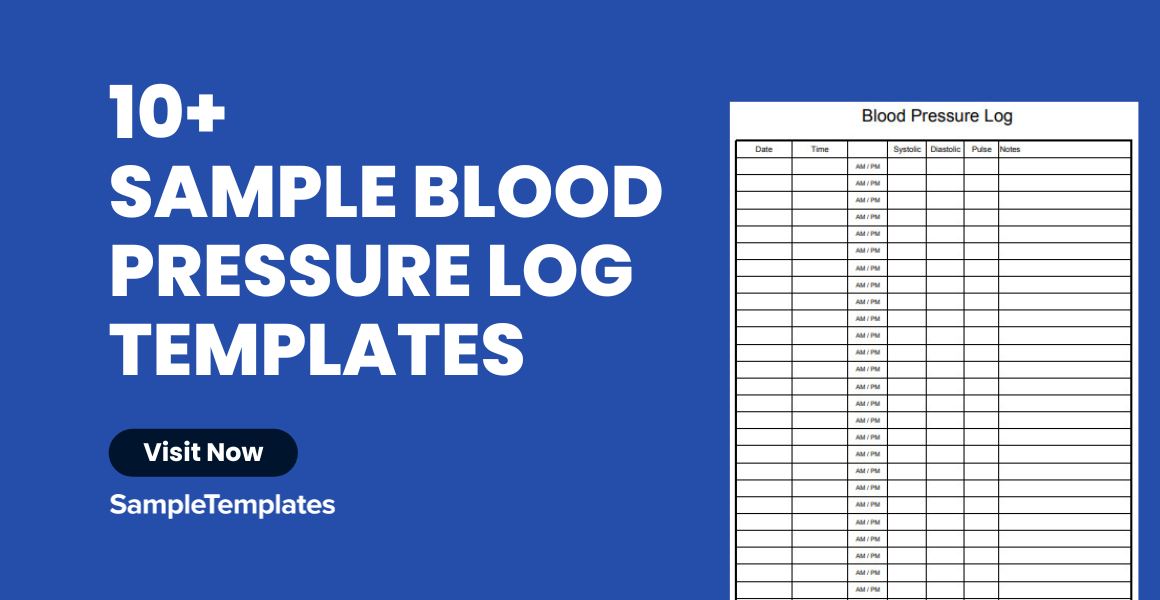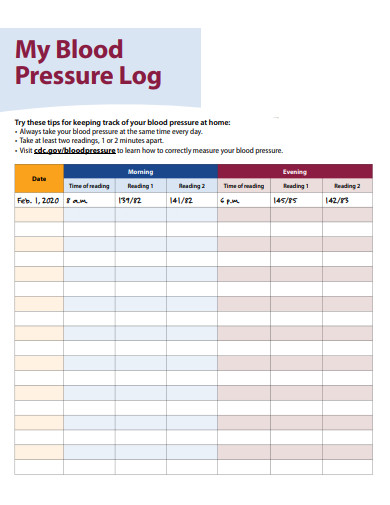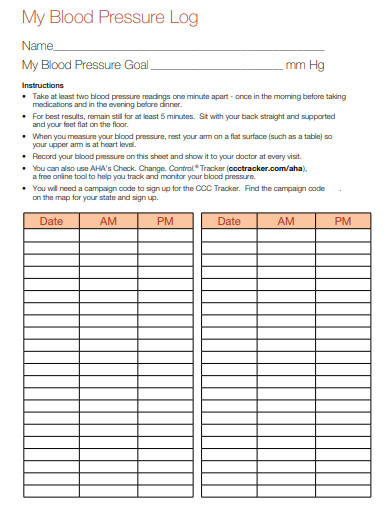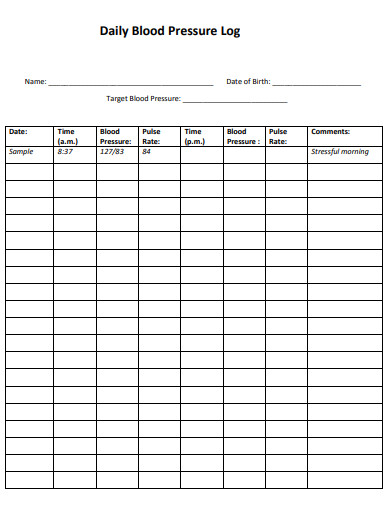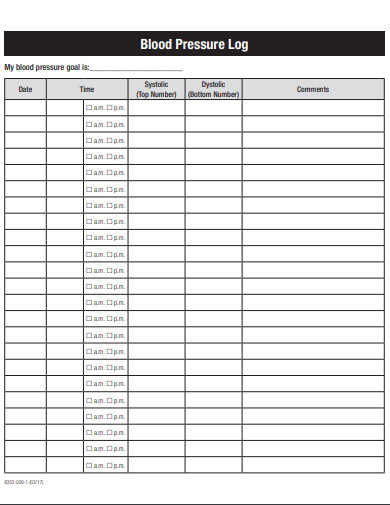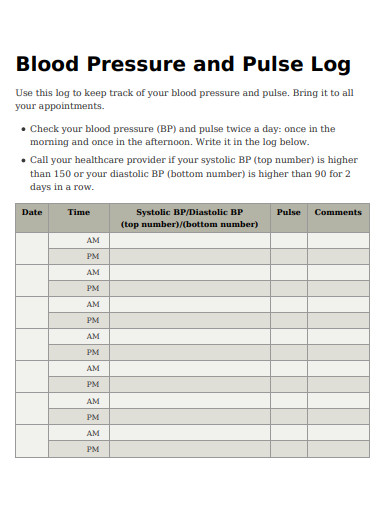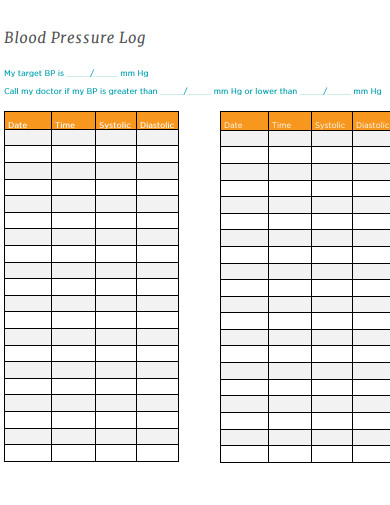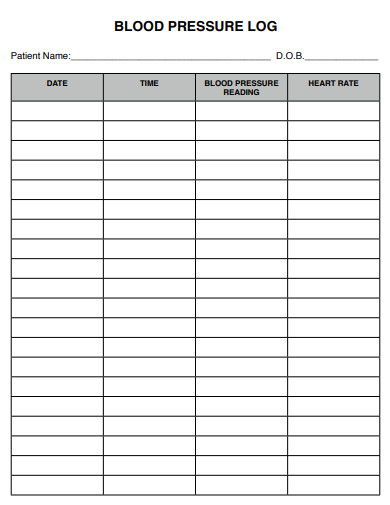Blood pressure is an important measure of cardiovascular health and can provide insight into the health of the heart and blood vessels. A blood pressure log is a record of a person’s blood pressure readings over a specific period of time and is used as tracking form for the changes in blood pressure chart samples and monitor overall cardiovascular health. It is important to take accurate blood pressure readings, as even minor fluctuations can indicate potential health issues. Blood pressure readings can be affected by a variety of factors, including stress, weekly activity schedule samples, and medication list samples. Keeping a log of all these factors can provide valuable information for healthcare providers when making decisions about treatment plan samples.
10+ Blood Pressure Log Samples
1. Blood Pressure Printable Log Chart
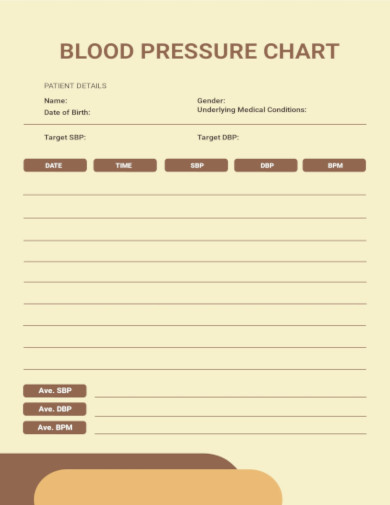
2. Blood Pressure Log Sheet
3. Blood Pressure Log
4. Daily Blood Pressure Log
5. Free Blood Pressure Log Sheet PDF
Which arm for blood pressure?
For most accurate blood pressure readings, it is generally recommended to measure blood pressure on the left arm. The left arm is preferred because it is closer to the heart, providing a more direct and accurate reflection of the circulatory system’s performance.
However, there are situations where the right arm may be used:
- Discrepancies or Discomfort: If there are significant differences in blood pressure readings between the arms, or if a medical condition or discomfort in the left arm prevents its use, the right arm may be considered.
- Patient’s Comfort: If a patient is more comfortable using the right arm, especially in cases of repeated measurements or self-monitoring, it is acceptable.
Regardless of the arm used, it is essential to remain consistent. Always use the same arm for measurements to ensure accurate tracking of blood pressure trends over time. Additionally, the arm should be supported at heart level during the measurement, and the cuff should fit correctly to avoid inaccurate readings. It’s advisable to follow any specific instructions provided by healthcare professionals for the most reliable results.
6. Free Printable Blood Pressure And Blood Sugar Log Sheet PDF
7. Sample Blood Pressure Log
How do you fill a blood pressure log?
Filling a blood pressure log involves regularly recording your blood pressure readings to monitor changes over time. Here’s a simple guide on how to fill a blood pressure log:
- Header Information: At the top of the log, write down the date you start tracking your blood pressure.
- Record Time and Date: Each time you measure your blood pressure, note the date and time of day (morning, afternoon, evening).
- Blood Pressure Readings: Record your blood pressure readings accurately. Include both systolic (top number) and diastolic (bottom number) values.
- Heart Rate: Optionally, you may choose to record your heart rate (pulse) along with your blood pressure readings.
- Additional Notes: Include any relevant information such as the circumstances surrounding the measurement (e.g., before or after a meal, physical activity, or medication).
- Consistency: Aim to measure your blood pressure at the same times each day for consistency. Follow any specific instructions provided by your healthcare professional.
- Review and Share: Regularly review your blood pressure log and share the information with your healthcare provider during check-ups. This data helps in managing and adjusting your treatment plan if necessary.
Remember, the accuracy and consistency of the readings are crucial. If you have specific guidelines from your healthcare provider, follow them closely. Regular monitoring can be valuable for managing hypertension and other cardiovascular conditions.
8. Blood Pressure and Pulse Log
9. Blood Pressure Log Template
10. Free Printable Blood Pressure And Weight Log
11. Simple Blood Pressure Log
What is Blood Pressure Log?
A blood pressure log is a record of a person’s blood pressure readings over a certain period of time. This can include the date and time of each reading, the systolic and diastolic blood pressure values, and any nurses note samples or observations related to the reading (such as symptoms, medication taken, etc.). Tracking blood pressure readings in a log can help individuals and their healthcare providers monitor blood pressure trends and determine if there are any underlying health issues that need to be addressed. Additionally, keeping a blood pressure log can also help individuals make lifestyle changes to improve their blood pressure and overall health.
How To Make Blood Pressure Log?
Keeping a blood pressure log can help individuals and their healthcare providers identify trends, monitor sample heart rate chart, and make informed decisions about lifestyle changes or treatment options. Making a blood pressure log is a simple and straightforward process that can be done with a pen and paper, or with the use of a smartphone app or spreadsheet. Here are the steps to create a blood pressure log:
Step 1- Gather Materials
You will need a notebook, a pen, and a blood pressure monitor. If you prefer to use an app or spreadsheet, there are many free options available for download. Decide how often you would like to take your blood pressure readings. It is recommended to take readings at the same time each day to account for any fluctuations that may occur throughout the day.
Step 2- Record the Date and Readings
Make a note of the date and time of each reading in your personal log book sample. Take your blood pressure reading using your blood pressure monitor and record the systolic and diastolic readings in your log.
Step 3- Make Notes
If you experienced any symptoms or took any personal medication list sample that could affect your blood pressure, make a note of it in your log. This can include any symptoms experienced during the reading, such as dizziness or headache, as well as any relevant information about medications taken or lifestyle factors that may affect blood pressure.
Step 4- Check and Calculate Your Range
Your healthcare provider should have set a target blood pressure range that is healthy for you. Compare your readings to this range and make a note in your log if any readings fall outside of the target range. Over time, you can calculate the average of your blood pressure readings to see if there are any trends or fluctuations.
General FAQs
1. How do you log blood pressure?
To log blood pressure, use a blood pressure monitor and record systolic and diastolic readings along with the date and time. Note any relevant details such as activity level or medication changes.
2. Why keep a blood pressure log?
Keeping a blood pressure log helps monitor and manage hypertension. It provides a record of readings over time, aiding healthcare professionals in assessing trends, adjusting treatment plans, and promoting overall cardiovascular health.
3. How often should I take blood pressure readings?
It is recommended to take blood pressure readings at the same time each day. The frequency of readings may vary depending on individual circumstances and the recommendation of a healthcare provider. Some individuals may take readings once a day, while others may take readings several times a day.
4. How can I ensure accurate blood pressure readings?
To ensure accurate blood pressure readings, it is important to take readings at the same time each day, avoid caffeine and physical activity before taking readings, and relax for a few minutes before taking readings. It is also important to use a properly calibrated blood pressure monitor.
5. Can stress affect blood pressure readings?
Yes, stress can affect blood pressure readings. It is important to make a note in your blood pressure log if you are experiencing stress or anxiety, as this may affect the accuracy of your readings.
In conclusion, keeping a blood pressure log is a valuable tool for monitoring cardiovascular health and making informed decisions about lifestyle changes and treatment plan samples. Accurate readings, lifestyle changes, and regular monitoring by a healthcare provider can help individuals maintain a healthy blood pressure and reduce the risk of heart disease and other cardiovascular conditions.
Related Posts
FREE 10+ Employee Log Samples in PDF
FREE 10+ Inventory Log Samples in PDF
FREE 10+ Personal Log Samples in PDF
FREE 10+ Cleaning Log Samples in PDF
FREE 10+ Daily Work Log Samples in PDF
FREE 10+ Sworn Affidavit Samples in PDF
FREE 10+ Tracking Log Samples in PDF | MS Word
FREE 10+ Receiving Log Samples in PDF
FREE 4+ Assumption Log Samples in PDF | DOC
FREE 10+ Issues Log Samples in PDF | DOC
Printing Company Profile
Travel Company Profile
Exemption Letter
News Report
Employee Uniform Form
